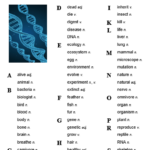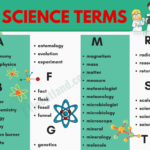Biology Terms That Start With T
1. Tissue – a group of similar cells that work together to perform a specific function.
2. Taxonomy – the classification of organisms into hierarchical categories based on their characteristics.
3. Transcription – the process by which the genetic information in DNA is used to produce a complementary RNA molecule.
4. Translation – the process by which the information in RNA is used to synthesize a specific protein.
5. Thylakoid – membrane-bound structures within chloroplasts where the light-dependent reactions of photosynthesis occur.
6. Telomere – a region of repetitive DNA at the end of a chromosome that protects it from degradation.
7. Trophic level – the position an organism occupies in a food chain or web, representing its feeding status.
8. Thermoregulation – the ability of an organism to maintain a stable body temperature through various physiological mechanisms.
9. Thigmotropism – the growth or movement of a plant in response to touch or physical contact.
10. Transposon – a DNA sequence that can change its position within a genome, potentially causing mutations or genetic variation.
11. Turbidity – the measure of the cloudiness or haziness of a fluid caused by suspended particles.
12. Turgor pressure – the pressure exerted on a cell wall by the protoplast as a result of water uptake.
13. Trophoblast – the outer layer of cells in the developing embryo that forms the placenta in mammals.
14. Thigmorphogenesis – the change in growth or development of a plant in response to mechanical stimulation.
15. Trachea – the windpipe; a tube connecting the larynx to the bronchi, allowing air to pass in and out of the lungs.
16. Totipotency – the ability of a single cell to give rise to a complete organism or differentiate into any cell type.
17. Thermophiles – organisms that thrive at high temperatures, often found in hot springs or deep-sea hydrothermal vents.
18. Trophozoite – the active feeding and growing stage of a protozoan parasite.
19. Transduction – the transfer of genetic material between bacteria through the use of bacteriophages.
20. Transpiration – the loss of water vapor from plant tissues through small openings called stomata.
21. Testis – the male reproductive organ responsible for producing sperm and testosterone.
22. Thylakoid lumen – the inner compartment within thylakoids where the light-dependent reactions of photosynthesis occur.
23. Tuberculosis – an infectious disease caused by the bacteria Mycobacterium tuberculosis, primarily affecting the lungs.
24. Trichome – small hair-like structures on plant surfaces, providing protection and various functions.
25. Trophic cascade – a series of changes in an ecosystem that originates from the addition or removal of a top predator.
26. Transcription factor – a protein that binds to specific DNA sequences, regulating the transcription of genes.
27. Thigmoperception – the ability of plants to perceive and respond to mechanical stimuli from their environment.
28. Telophase – the final stage of mitosis or meiosis, during which chromosomes decondense and new nuclear membranes form.
29. Thigmotactic – the behavior of an organism moving towards or away from contact with an object or surface.
30. Tropism – the growth or movement of a plant in response to an external stimulus, such as light or gravity.
More About Biology Terms That Start With T
Welcome to an illuminating journey through the vast universe of biology, where we delve into the captivating world of terms starting with the letter “T.” From intricate organisms to fundamental processes, this collection of biology terms will unlock the mysteries of life, enabling a deeper understanding and appreciation of our magnificent planet.
Our exploration begins with “Taxonomy,” a field that classifies and categorizes organisms based on their shared characteristics. Through this system, biologists can uncover the evolutionary relationships between species, providing a framework for the study and understanding of biodiversity.
Next, we encounter the awe-inspiring phenomenon of “Turgor Pressure.” This term refers to the pressure exerted by fluids (usually water) within plant cells, contributing to their rigidity and structure. Turgor pressure is vital for maintaining upright plant forms, ensuring nutrient transportation, and even enabling the closure of stomata, the microscopic pores used for gas exchange in leaves.
Moving on, we uncover the enigmatic realm of “Transcription,” a process that occurs in all organisms and forms the basis of gene expression. Transcription involves the reading and copying of genetic information (DNA) into a single-stranded molecule called RNA. This RNA molecule then serves as a blueprint for protein synthesis in a process known as translation.
Within the intricate workings of living organisms, “Telomeres” play a vital role. These protective structures, found at the ends of chromosomes, safeguard the genetic information during cell division. With each replication cycle, telomeres naturally shorten, ultimately leading to cell senescence or programmed cell death (apoptosis). Understanding telomeres is crucial in unraveling the mechanisms of aging and potential interventions in age-related diseases.
Transportation within living systems is a fundamental process, and the “Transport Proteins” become key players in this exchange of essential molecules such as ions and nutrients. These proteins create channels and carriers within cell membranes, facilitating the movement of substances in and out of cells. By exploring the diverse types and functions of transport proteins, we can gain insight into various physiological processes, including nerve signal transmission, muscle contractions, and nutrient absorption.
In the remarkable realm of ecology, the concept of “Trophic Levels” takes center stage. Trophic levels represent the different levels in a food chain, with each level containing organisms that share the same position in the transfer of energy and nutrients. Understanding the intricate relationships between trophic levels illuminates the balance and dynamics of energy flow through ecosystems, highlighting the interconnectedness of all living organisms.
Transitioning to the microscopic, we encounter the tiny yet powerful “T-cells.” These specialized white blood cells play a pivotal role in coordinating the immune response, protecting the body against invading pathogens. T-cells recognize and destroy infected cells or abnormal cells within our bodies, providing a crucial defense mechanism against infections, cancer, and autoimmune diseases.
Our journey through biology terms starting with “T” offers a glimpse into the astonishing interconnectedness and complexity of life. From taxonomy to t-cells, each term unravels a distinct aspect of the intricate tapestry of biology, allowing us to appreciate the wonders that surround us.
Join us as we embark on this enthralling exploration, unraveling the captivating world of biology and its many “T” terms, providing a deeper understanding and fostering an enduring curiosity about the natural world. Stay tuned for our upcoming articles that will delve into each term in greater detail, shedding light on the fascinating mechanisms and phenomena that shape the awe-inspiring field of biology.
Biology Terms That Start With T FAQs:
FAQ: Biology Terms Starting with “T”
1. Q: What is a tectonic plate?
A: Tectonic plates are large, rigid pieces of Earth’s lithosphere that move and interact with each other.
2. Q: What is taxonomy?
A: Taxonomy is the scientific discipline that classifies and categorizes living organisms into various hierarchical levels based on their similarities and evolutionary relationships.
3. Q: What is a trophic level?
A: A trophic level refers to the position of an organism in a food chain or food web, indicating its source of energy and its role as a producer or consumer.
4. Q: What is transpiration?
A: Transpiration is the process by which water moves from the roots of plants to the leaves, where it evaporates into the atmosphere.
5. Q: What is the function of a trachea in humans?
A: The trachea, also known as the windpipe, is responsible for carrying air to and from the lungs, ensuring the oxygen required by the body is supplied and carbon dioxide is expelled.
6. Q: What is a tumor?
A: A tumor is an abnormal growth of cells that can be either benign (non-cancerous) or malignant (cancerous) and may invade and damage surrounding tissues.
7. Q: What is transcription?
A: Transcription is the process by which genetic information encoded in DNA is copied into RNA molecules, specifically messenger RNA (mRNA).
8. Q: What is the function of the thyroid gland?
A: The thyroid gland produces hormones (such as thyroxine) that regulate metabolism, growth, and development in the body.
9. Q: What is a trophoblast?
A: The trophoblast is the outer layer of cells that forms during early embryonic development and plays a crucial role in implantation and the formation of the placenta in mammals.
10. Q: What is transduction in biology?
A: Transduction is a process by which foreign DNA is transferred into a bacterial cell by a virus, which then integrates the foreign DNA into its own genetic material.













